Shrewsbury Abbey: Difference between revisions
Created page with "{{Infobox church |name=Shrewsbury Abbey |county=Shropshire |full name=The Abbey Church of Saint Peter<br />and Saint Paul, Shrewsbury |church=Church of England |diocese=Lichfi..." |
No edit summary |
||
| Line 14: | Line 14: | ||
|website=[http://www.shrewsburyabbey.com/ shrewsburyabbey.com] | |website=[http://www.shrewsburyabbey.com/ shrewsburyabbey.com] | ||
}} | }} | ||
The '''Abbey Church of Saint Peter and Saint Paul, Shrewsbury''' (commonly known as '''Shrewsbury Abbey''') is an ancient parish church [[Shrewsbury]], the [[county town]] of [[Shropshire]]. Until the Reformation, it was the church belonging to the town's great abbey, hence its name. | The '''Abbey Church of Saint Peter and Saint Paul, Shrewsbury''' (commonly known as '''Shrewsbury Abbey''') is an ancient parish church in [[Shrewsbury]], the [[county town]] of [[Shropshire]]. Until the Reformation, it was the church belonging to the town's great abbey, hence its name. | ||
The Abbey was founded in 1083 as a Benedictine monastery by the Norman Earl of Shrewsbury, Roger de Montgomery. It grew to be one of the most important and influential abbeys in England and an important centre of pilgrimage. Although much of the Abbey was destroyed in the 16th century, the nave survived as a parish church and today serves as the mother church for the Parish of Holy Cross, and the civic church of Shrewsbury. | The Abbey was founded in 1083 as a Benedictine monastery by the Norman Earl of Shrewsbury, Roger de Montgomery. It grew to be one of the most important and influential abbeys in England and an important centre of pilgrimage. Although much of the Abbey was destroyed in the 16th century, the nave survived as a parish church and today serves as the mother church for the Parish of Holy Cross, and the civic church of Shrewsbury. | ||
| Line 28: | Line 28: | ||
Shrewsbury Abbey was dissolved in 1540 under King Henry VIII, and its estates seized by the Crown. A pension of £80 was assigned to the abbot and £87 6s. 8d. to the 17 monks.<ref>{{cite web |url=http://www.shrewsburyabbey.com/History%20Page.html |title=Shrewsbury Abbey website|date=|work=|publisher=Shrewsbury Abbey |accessdate=19 April 2013 }}</ref> | Shrewsbury Abbey was dissolved in 1540 under King Henry VIII, and its estates seized by the Crown. A pension of £80 was assigned to the abbot and £87 6s. 8d. to the 17 monks.<ref>{{cite web |url=http://www.shrewsburyabbey.com/History%20Page.html |title=Shrewsbury Abbey website|date=|work=|publisher=Shrewsbury Abbey |accessdate=19 April 2013 }}</ref> | ||
As part of this the 'Henrician Reformation', the King devised a plan to form at least thirteen new dioceses so that most counties had a cathedral. It was intended that Shrewsbury Abbey become a cathedral for Shropshire, but, while new dioceses were indeed established at [[Bristol]], [[Gloucester]], [[Oxford]], [[Peterborough]], [[Westminster]], and [[Chester]], the plans were never completed at [[Shrewsbury]], [[Leicester]], or [[Waltham]].<ref>J. D. Mackie, The Earlier Tudors, Oxford History of England, pp 399-400</ref> | As part of this the 'Henrician Reformation', the King devised a plan to form at least thirteen new dioceses so that most counties had a cathedral. It was intended that Shrewsbury Abbey become a cathedral for Shropshire, but, while new dioceses were indeed established at [[Bristol]], [[Gloucester]], [[Oxford]], [[Peterborough]], [[Westminster]], and [[Chester]], the plans were never completed at [[Shrewsbury]], [[Leicester]], or [[Waltham Abbey|Waltham]].<ref>J. D. Mackie, The Earlier Tudors, Oxford History of England, pp 399-400</ref> | ||
[[File:ShrewsburyAbbeyPulpit.JPG|right|thumb|200px|The old refectory pulpit.]] | [[File:ShrewsburyAbbeyPulpit.JPG|right|thumb|200px|The old refectory pulpit.]] | ||
===Since the Reformation=== | ===Since the Reformation=== | ||
The western part of the Abbey (nave, side aisles, porch and west tower) was preserved as a parish church and the remaining buildings were either adapted to secular uses or pulled down. The building suffered severely from neglect after the Reformation. The lead from the roof was removed, leading to decay and eventual collapse. The Norman | The western part of the Abbey (nave, side aisles, porch and west tower) was preserved as a parish church and the remaining buildings were either adapted to secular uses or pulled down. The building suffered severely from neglect after the Reformation. The lead from the roof was removed, leading to decay and eventual collapse. The Norman clerestory was still in existence in the 17th century but it was later taken down and the roof was rebuilt immediately above the triforium. Considerable portions of the monastic buildings were still standing in 1743 but most have since been demolished, particularly when Thomas Telford built his A5 road through the Abbey grounds c.1836, removing much of the remaining evidence of the monastic layout. The old refectory pulpit is still visible across the road from the church and a single wall of an Abbey building, now an integral part of another building, remains. In the late 19th century the possibility of the Abbey becoming a cathedral was again considered, but legislation to that effect, drafted in 1922, was defeated by one vote in the House of Lords in 1926. | ||
[[File:Shrewsbury Abbey from the west - geograph.org.uk - 56158.jpg|thumb|alt=Flooding in Abbey Foregate.|Flooding in Abbey Foregate.]] | [[File:Shrewsbury Abbey from the west - geograph.org.uk - 56158.jpg|thumb|alt=Flooding in Abbey Foregate.|Flooding in Abbey Foregate.]] | ||
| Line 39: | Line 39: | ||
Much of the original Norman, 11th century, building survives in the present Abbey church, notably the short thick piers in the eastern half of the nave and the remnants of the original transepts. Stones with three sculptured figures, representing John the Baptist, St Winifred and St Beuno, were found in a garden and have been restored to their original position in the screen. During the 19th century there were major restoration projects to restore the clerestory, and the east end of the church was redesigned by John Loughborough Pearson to contain a chancel and sanctuary. | Much of the original Norman, 11th century, building survives in the present Abbey church, notably the short thick piers in the eastern half of the nave and the remnants of the original transepts. Stones with three sculptured figures, representing John the Baptist, St Winifred and St Beuno, were found in a garden and have been restored to their original position in the screen. During the 19th century there were major restoration projects to restore the clerestory, and the east end of the church was redesigned by John Loughborough Pearson to contain a chancel and sanctuary. | ||
Inside the west end, on opposite walls, are stone war memorial tablets to parishioners who died serving in the separate World Wars. Among the names on that for the First World War is the war poet Wilfrred Owen (as Lieutenant W.E.S. Owen M.C., Manchester Regiment). In the Abbey churchyard is a memorial sculpture erected by the Wilfred Owen Association on his birth centenary (1993) by | Inside the west end, on opposite walls, are stone war memorial tablets to parishioners who died serving in the separate World Wars. Among the names on that for the First World War is the war poet Wilfrred Owen (as Lieutenant W.E.S. Owen M.C., Manchester Regiment). In the Abbey churchyard is a memorial sculpture erected by the Wilfred Owen Association on his birth centenary (1993) by Paul de Monchaux, incorporating a line from his poem ''Strange Meeting'' inscribed by Paul's wife, Ruth.<ref>{{cite book|last=Francis|first=Peter|title=Shropshire War Memorials, Sites of Remembrance|year=2013|publisher=YouCaxton Publications|pages=193-194|isbn=978-1-909644-11-3}}</ref> | ||
In recent times, the area surrounding the Abbey has been prone to flooding. | In recent times, the area surrounding the Abbey has been prone to flooding. | ||
| Line 45: | Line 45: | ||
[[File:ShrewsburyAbbeyClock.JPG|right|thumb|200px|The Clock on the bell tower, with unusual markings]] | [[File:ShrewsburyAbbeyClock.JPG|right|thumb|200px|The Clock on the bell tower, with unusual markings]] | ||
==Bells== | ==Bells== | ||
At the Dissolution, the Abbey had two rings of five bells, one in the current tower and one in a central tower. In 1673 a ring of eight was cast by George Oldfield of Nottingham and these were replaced over time by the present bells. Nine peals were rung at the Abbey in the eighteenth century.<ref>{{cite web |url=http://cccbr.org.uk/felstead/tbid.php?tid=7149 |title=Felstead Database |accessdate=17 September 2013 }}</ref> The bells were rung full-circle until at least 1895 but in 1909 concern over the safety of the tower led to the bells being removed and rehung without wheels in a new frame. They are currently sounded by an | At the Dissolution, the Abbey had two rings of five bells, one in the current tower and one in a central tower. In 1673 a ring of eight was cast by George Oldfield of Nottingham and these were replaced over time by the present bells. Nine peals were rung at the Abbey in the eighteenth century.<ref>{{cite web |url=http://cccbr.org.uk/felstead/tbid.php?tid=7149 |title=Felstead Database |accessdate=17 September 2013 }}</ref> The bells were rung full-circle until at least 1895 but in 1909 concern over the safety of the tower led to the bells being removed and rehung without wheels in a new frame. They are currently sounded by an Ellacombe apparatus, whereby they can be rung by a single person.<ref>{{cite web |url=http://sacbr.org.uk/S'y%20Abbey/Shrewsbury%20Abbey.htm |title=Shropshire Association of Church Bellringers |date=|work=|publisher=|accessdate=19 April 2013 }}</ref> | ||
==Music== | ==Music== | ||
[[File:Shrewsbury Abbey Altar and Organ, Shropshire, UK - Diliff.jpg|right|thumb|200px|The choir stalls and organ]] | [[File:Shrewsbury Abbey Altar and Organ, Shropshire, UK - Diliff.jpg|right|thumb|200px|The choir stalls and organ]] | ||
The Abbey has a long-standing reputation for excellence in liturgical music. Records from the mid 19th century show the existence of a choir of boys and men, which was maintained until after Second World War. The senior choir regularly visits cathedrals to sing services in the absence of the cathedral choir. | The Abbey has a long-standing reputation for excellence in liturgical music. Records from the mid-19th century show the existence of a choir of boys and men, which was maintained until after Second World War. The senior choir regularly visits cathedrals to sing services in the absence of the cathedral choir. | ||
The Abbey has a fine organ, built in 1911 by William Hill and Son. It was designed to be on the scale of a cathedral organ, but lack of funds meant the original scheme was never completed. Some stops were subsequently added but, today, it is still incomplete. The quality of the Hill organ and the richness of its Edwardian tone still shine through after 100 years of service, and the organ is a wonderful and fitting complement to the beauty of this ancient Abbey church. The console is also in original condition and is unusual for the right side positioning of the swell pedals, and for the sight of stop stubs (7) for the “missing” ranks. | The Abbey has a fine organ, built in 1911 by William Hill and Son. It was designed to be on the scale of a cathedral organ, but lack of funds meant the original scheme was never completed. Some stops were subsequently added but, today, it is still incomplete. The quality of the Hill organ and the richness of its Edwardian tone still shine through after 100 years of service, and the organ is a wonderful and fitting complement to the beauty of this ancient Abbey church. The console is also in original condition and is unusual for the right side positioning of the swell pedals, and for the sight of stop stubs (7) for the “missing” ranks. | ||
| Line 55: | Line 55: | ||
==In literature and popular fiction== | ==In literature and popular fiction== | ||
===Cadfael=== | ===Cadfael=== | ||
Shrewsbury Abbey is the setting for the "Cadfael" mysteries by Ellis Peters, in which the fictional '''Brother Cadfael''' is embroiled in a series of murder mysteries. The character of Cadfael is a Welsh Benedictine monk living at the Abbey in the first half of the 12th century. The historically accurate stories<ref>Kaler (1998 p11</ref> are set between about 1135 and about 1145, during "The Anarchy", the destructive contest for the crown of England between King Stephen and the Empress Maud. One of the stories turns on the expedition to bring the bones of St Winifred from Wales. | Shrewsbury Abbey is the setting for the "Cadfael" mysteries by Ellis Peters, in which the fictional '''Brother Cadfael''' is embroiled in a series of murder mysteries. The character of Cadfael is a Welsh Benedictine monk living at the Abbey in the first half of the 12th century. The historically accurate stories<ref>Kaler (1998) p11</ref> are set between about 1135 and about 1145, during "The Anarchy", the destructive contest for the crown of England between King Stephen and the Empress Maud. One of the stories turns on the expedition to bring the bones of St Winifred from Wales. | ||
==Outside links== | ==Outside links== | ||
Latest revision as of 17:53, 31 March 2020
| Shrewsbury Abbey | |
|
The Abbey Church of Saint Peter | |
|---|---|
|
Shropshire | |
| Status: | Parish church |
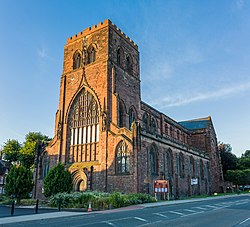 Shrewsbury Abbey | |
| Church of England | |
| Diocese of Lichfield | |
| Location | |
| Grid reference: | SJ498124 |
| Location: | 52°42’27"N, 2°44’38"W |
| History | |
| Information | |
| Website: | shrewsburyabbey.com |
The Abbey Church of Saint Peter and Saint Paul, Shrewsbury (commonly known as Shrewsbury Abbey) is an ancient parish church in Shrewsbury, the county town of Shropshire. Until the Reformation, it was the church belonging to the town's great abbey, hence its name.
The Abbey was founded in 1083 as a Benedictine monastery by the Norman Earl of Shrewsbury, Roger de Montgomery. It grew to be one of the most important and influential abbeys in England and an important centre of pilgrimage. Although much of the Abbey was destroyed in the 16th century, the nave survived as a parish church and today serves as the mother church for the Parish of Holy Cross, and the civic church of Shrewsbury.
The church is located to the east of Shrewsbury town centre, near to the English Bridge, and is surrounded by a triangular area which is today referred to as Abbey Foregate and is a Grade I Listed Building.[1] It
History
Foundation
Before the Norman Conquest there stood a small chapel dedicated to St Peter outside the east gate of Shrewsbury, which had been built by Siward son of Ethelgar. When Roger de Montgomery received Shropshire from William the Conqueror in 1071, he gave the church to one of his clerks, Odelerius of Orléans. In February 1083 Earl Roger publicly pledged himself to found a new Abbey, laying his gloves on the altar of St Peter and granting the whole suburb outside the east gate for the construction.[2] The work was sufficiently in 1087 for the first Abbot, Fulchred of Séez, to be installed. During the 12th century the 5th Abbot, Robert Pennant, conveniently discovered the remains of Saint Winifred during a pilgrimage to Wales and brought the bones to the Abbey, which caused Shrewsbury to become an important place of pilgrimage, bringing wealth to the abbey, During the 14th century considerable rebuilding work was done at the west end of the Abbey. Records shows that the great west window was glazed c.1388 in the time of Abbot Nicholas Stevens, who may also have been responsible for other 14th century alterations.
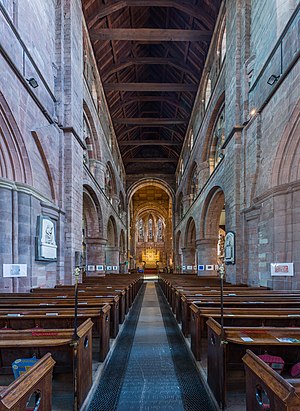
Dissolution
Shrewsbury Abbey was dissolved in 1540 under King Henry VIII, and its estates seized by the Crown. A pension of £80 was assigned to the abbot and £87 6s. 8d. to the 17 monks.[3]
As part of this the 'Henrician Reformation', the King devised a plan to form at least thirteen new dioceses so that most counties had a cathedral. It was intended that Shrewsbury Abbey become a cathedral for Shropshire, but, while new dioceses were indeed established at Bristol, Gloucester, Oxford, Peterborough, Westminster, and Chester, the plans were never completed at Shrewsbury, Leicester, or Waltham.[4]
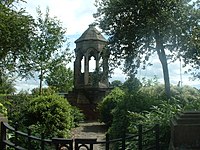
Since the Reformation
The western part of the Abbey (nave, side aisles, porch and west tower) was preserved as a parish church and the remaining buildings were either adapted to secular uses or pulled down. The building suffered severely from neglect after the Reformation. The lead from the roof was removed, leading to decay and eventual collapse. The Norman clerestory was still in existence in the 17th century but it was later taken down and the roof was rebuilt immediately above the triforium. Considerable portions of the monastic buildings were still standing in 1743 but most have since been demolished, particularly when Thomas Telford built his A5 road through the Abbey grounds c.1836, removing much of the remaining evidence of the monastic layout. The old refectory pulpit is still visible across the road from the church and a single wall of an Abbey building, now an integral part of another building, remains. In the late 19th century the possibility of the Abbey becoming a cathedral was again considered, but legislation to that effect, drafted in 1922, was defeated by one vote in the House of Lords in 1926.
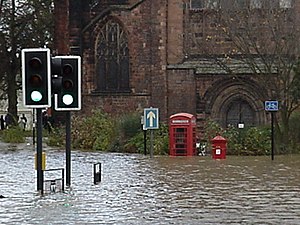
Present-day church
Much of the original Norman, 11th century, building survives in the present Abbey church, notably the short thick piers in the eastern half of the nave and the remnants of the original transepts. Stones with three sculptured figures, representing John the Baptist, St Winifred and St Beuno, were found in a garden and have been restored to their original position in the screen. During the 19th century there were major restoration projects to restore the clerestory, and the east end of the church was redesigned by John Loughborough Pearson to contain a chancel and sanctuary.
Inside the west end, on opposite walls, are stone war memorial tablets to parishioners who died serving in the separate World Wars. Among the names on that for the First World War is the war poet Wilfrred Owen (as Lieutenant W.E.S. Owen M.C., Manchester Regiment). In the Abbey churchyard is a memorial sculpture erected by the Wilfred Owen Association on his birth centenary (1993) by Paul de Monchaux, incorporating a line from his poem Strange Meeting inscribed by Paul's wife, Ruth.[5]
In recent times, the area surrounding the Abbey has been prone to flooding.
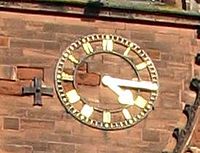
Bells
At the Dissolution, the Abbey had two rings of five bells, one in the current tower and one in a central tower. In 1673 a ring of eight was cast by George Oldfield of Nottingham and these were replaced over time by the present bells. Nine peals were rung at the Abbey in the eighteenth century.[6] The bells were rung full-circle until at least 1895 but in 1909 concern over the safety of the tower led to the bells being removed and rehung without wheels in a new frame. They are currently sounded by an Ellacombe apparatus, whereby they can be rung by a single person.[7]
Music
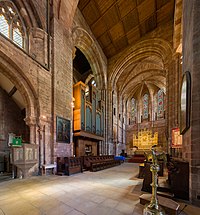
The Abbey has a long-standing reputation for excellence in liturgical music. Records from the mid-19th century show the existence of a choir of boys and men, which was maintained until after Second World War. The senior choir regularly visits cathedrals to sing services in the absence of the cathedral choir.
The Abbey has a fine organ, built in 1911 by William Hill and Son. It was designed to be on the scale of a cathedral organ, but lack of funds meant the original scheme was never completed. Some stops were subsequently added but, today, it is still incomplete. The quality of the Hill organ and the richness of its Edwardian tone still shine through after 100 years of service, and the organ is a wonderful and fitting complement to the beauty of this ancient Abbey church. The console is also in original condition and is unusual for the right side positioning of the swell pedals, and for the sight of stop stubs (7) for the “missing” ranks.
In literature and popular fiction
Cadfael
Shrewsbury Abbey is the setting for the "Cadfael" mysteries by Ellis Peters, in which the fictional Brother Cadfael is embroiled in a series of murder mysteries. The character of Cadfael is a Welsh Benedictine monk living at the Abbey in the first half of the 12th century. The historically accurate stories[8] are set between about 1135 and about 1145, during "The Anarchy", the destructive contest for the crown of England between King Stephen and the Empress Maud. One of the stories turns on the expedition to bring the bones of St Winifred from Wales.
Outside links
References
- ↑ Abbey Church of the Holy Cross, Shrewsbury - British Listed Buildings
- ↑ "Shrewsbury Abbey website". http://www.shrewsburyabbey.com/History%20Page.html. Retrieved 19 April 2013.
- ↑ "Shrewsbury Abbey website". Shrewsbury Abbey. http://www.shrewsburyabbey.com/History%20Page.html. Retrieved 19 April 2013.
- ↑ J. D. Mackie, The Earlier Tudors, Oxford History of England, pp 399-400
- ↑ Francis, Peter (2013). Shropshire War Memorials, Sites of Remembrance. YouCaxton Publications. pp. 193-194. ISBN 978-1-909644-11-3.
- ↑ "Felstead Database". http://cccbr.org.uk/felstead/tbid.php?tid=7149. Retrieved 17 September 2013.
- ↑ "Shropshire Association of Church Bellringers". http://sacbr.org.uk/S'y%20Abbey/Shrewsbury%20Abbey.htm. Retrieved 19 April 2013.
- ↑ Kaler (1998) p11